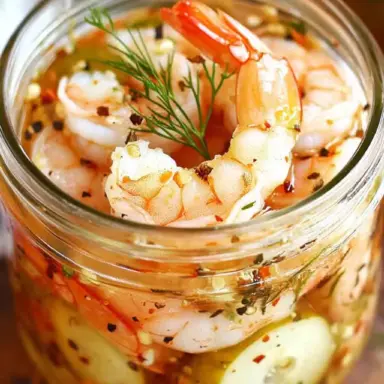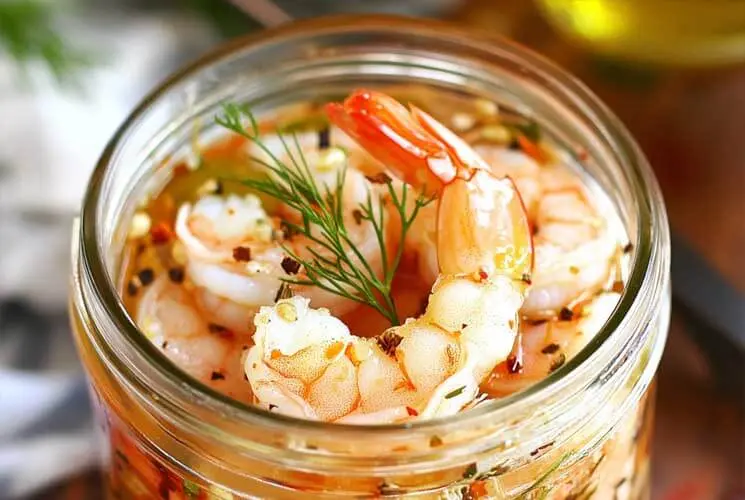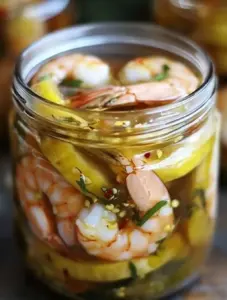Pickled shrimp is a beloved Southern delicacy that combines the briny bite of seafood with the tangy kick of vinegar and spices. Often served chilled, this dish has roots that stretch deep into the coastal traditions of the American South—particularly in states like Georgia, South Carolina, and Louisiana. With its crisp texture and bold flavor profile, pickled shrimp has earned a place on many appetizer tables, from casual backyard cookouts to elegant holiday buffets.
As an hors d’oeuvre, it’s prized for being easy to prepare ahead of time and even better when made a day in advance. In recent years, pickled shrimp has made a noticeable comeback, finding new fans in modern food circles who value its zesty, refreshing profile and versatility. Whether served in small jars, over crackers, or atop leafy greens, this pickled shrimp recipe offers a perfect mix of old-school charm and contemporary appeal.
Historical Background & Cultural Significance
The origins of the pickled shrimp recipe can be traced back to the culinary traditions of coastal communities in the Southern United States. Shrimp was abundant in these regions, and pickling served not only as a method of preservation before refrigeration but also as a flavorful way to extend the life of seafood after large catches.
Originally embraced by coastal fishermen and families, the dish became a staple during festive occasions—especially during summer months and around the holidays. Generations of Southern cooks refined the recipe, passing it down with subtle variations that reflect family traditions and local flavors. In states like South Carolina and Mississippi, pickled shrimp became a classic feature at weddings, Christmas parties, and potlucks.
Beyond mere nostalgia, pickled shrimp embodies the resourcefulness of early Southern cooking. Using vinegar, oil, herbs, and aromatics, home cooks turned simple shrimp into something bright and crave-worthy. Today, it’s not just a way to preserve shrimp—it’s a culinary tradition celebrated for its taste and cultural depth, often appearing alongside other Southern favorites like pimento cheese or deviled eggs.
Essential Ingredients for Pickled Shrimp
Creating the perfect pickled shrimp recipe starts with a balance of freshness, acidity, and spice. Here’s a look at the foundational ingredients and how to choose the best:
Core Ingredients:
-
Shrimp: Medium to large, peeled and deveined. Wild-caught Gulf shrimp are ideal, but frozen works well too (just thaw completely).
-
Vinegar: Apple cider vinegar adds sweetness and complexity, but white wine vinegar offers a more delicate tang.
-
Oil: A neutral oil like vegetable or grapeseed helps emulsify the pickling brine. Olive oil is less traditional but adds richness.
-
Aromatics: Thinly sliced onions, garlic, and lemon or lime slices provide depth and visual appeal.
-
Spices: Bay leaves, black peppercorns, crushed red pepper flakes, mustard seeds, and sometimes allspice or clove for warmth.
-
Fresh herbs: Dill, thyme, or parsley can be added for brightness and aroma.
Tips for Ingredient Quality:
-
Opt for wild-caught or sustainably farmed shrimp when possible.
-
Use fresh citrus juice and zest for bold flavor.
-
Avoid iodized salt; use kosher or sea salt for a cleaner taste.
-
Customize heat levels with chili flakes, hot sauce, or jalapeño slices.
While traditional recipes remain simple, modern takes might include bell peppers, fennel, or even pickled okra to add texture and a Southern twist.
Step-by-Step Preparation Guide
Here’s how to make a traditional and flavorful pickled shrimp recipe at home.
Step 1: Cook the Shrimp
Bring a large pot of salted water to a gentle boil. Add shrimp and cook for 2–3 minutes, just until pink and firm. Do not overcook. Immediately transfer them to an ice bath to halt cooking and maintain a crisp texture.
Alternative: Steam shrimp for a more concentrated flavor.
2: Make the Pickling Liquid
In a saucepan, combine:
-
1 cup vinegar
-
½ cup water
-
¼ cup oil
-
1 tsp salt
-
1 tbsp sugar
-
Aromatics: 2 bay leaves, 1 tsp peppercorns, crushed garlic, and citrus slices
Simmer for 3–5 minutes to infuse the flavors, then let the brine cool to room temperature.
3: Layer & Pack
In a large jar or container:
-
Layer cooked shrimp with onion slices, lemon rounds, and herbs.
-
Pour the cooled brine over the layers until completely submerged.
-
Seal and refrigerate.
4: Marinate & Serve
Allow shrimp to marinate in the fridge for at least 8 hours, preferably overnight. The longer it sits, the more intense the flavor. Pickled shrimp is best enjoyed within 3–5 days for peak taste and texture.
Storage Tips:
-
Store in airtight glass containers for freshness.
-
Always use a clean utensil to avoid contamination.
This quick process turns a simple shrimp dish into something tangy, aromatic, and unforgettable—perfect for serving chilled at your next gathering.
Popular Variations of Pickled Shrimp
One of the most exciting aspects of a classic pickled shrimp recipe is how easy it is to personalize. Across regions—and even continents—variations abound, each bringing its own bold character.
Louisiana-Style Pickled Shrimp
Infused with Creole seasoning, this Southern twist leans on spices like paprika, cayenne, oregano, and thyme. It often includes:
-
Celery seed
-
Worcestershire sauce
Advertisement -
Creole mustard This version has more depth and heat, making it a favorite in New Orleans-style holiday spreads.
Asian-Inspired Pickled Shrimp
Looking for something fresh and zingy? Asian takes add bold, aromatic flavors. Think:
-
Rice vinegar instead of apple cider vinegar
-
Fresh ginger slices
-
Soy sauce
-
Sesame oil Add green onions and a touch of chili garlic paste for an umami-packed variation. These pair beautifully with rice noodles or slaw.
Vegetable-Enhanced Variations
Modern versions often incorporate extra veggies for color, crunch, and complexity:
-
Thin-sliced fennel offers an anise-like freshness.
-
Bell peppers (especially red and yellow) add a sweet, crisp balance.
-
Carrots, radishes, and even jalapeños provide additional texture and visual flair.
These tweaks not only elevate flavor but also transform your dish into a beautiful, vibrant mason jar appetizer—great for gifting or entertaining. Experimenting with different herbs, oils, or spice profiles can help you create a signature version that reflects your kitchen style.
Serving Suggestions & Pairings
Pickled shrimp is an appetizer that begs to be shared, and the way it’s served can make all the difference.
Best Pairings:
-
Crackers or Crostini: Let guests scoop shrimp and onions onto crisp bread or salty crackers.
-
Crusty Baguette: Use it to soak up the flavorful pickling juices.
-
Simple Greens: Serve over arugula or mixed greens for a light seafood salad.
Elevate Your Plating:
-
Spoon shrimp into small glass jars or cocktail glasses for individual servings at parties.
-
Arrange them with other Southern favorites like deviled eggs, pimento cheese, or pickled okra on a charcuterie board.
-
Drizzle a bit of the pickling liquid over the dish for extra zest and visual appeal.
Pickled shrimp also shines in:
-
Tacos or lettuce wraps
-
Grain bowls
-
As a garnish for Bloody Marys
However you serve it, this dish always feels fresh, flavorful, and festive.
Frequently Asked Questions (FAQs)
How long can pickled shrimp be stored?
Properly refrigerated, pickled shrimp lasts up to 5 days in an airtight glass container. The flavor continues to develop over the first few days, but for food safety and texture, don’t push past a week.
Can I use frozen shrimp?
Absolutely. Just fully thaw the shrimp and pat them dry before cooking. Frozen shrimp are often flash-frozen at peak freshness, making them a great year-round option.
Do I need to cook the shrimp first?
Yes. Always cook the shrimp (usually via boiling or steaming) before pickling. Raw shrimp won’t pickle properly and may pose a health risk.
What types of vinegar work best?
Apple cider vinegar is the most traditional, offering a mild sweetness. For lighter versions, use white wine vinegar or rice vinegar. Avoid distilled white vinegar—it can overpower the delicate flavor of the shrimp.
Can I reuse the pickling liquid?
No. Once used, the brine contains juices from the cooked shrimp. Reusing it can introduce bacteria. However, you can strain and reduce leftover brine into a vinaigrette for salads if consumed quickly.
Can I make it less salty?
Yes—use low-sodium salt, and rinse the cooked shrimp gently before layering. Adjust the salt in the pickling liquid to taste.
Nutritional Information & Health Benefits
Pickled shrimp is as nutritious as it is delicious. It’s a lean, high-protein appetizer that’s:
-
Low in calories (about 100–120 per 3 oz serving)
-
Rich in omega-3 fatty acids
-
A good source of selenium, iodine, and vitamin B12
Thanks to the vinegar-based brine, the dish is keto-friendly and suitable for low-carb diets. Adding fresh herbs like dill, garlic, and lemon also provides antioxidants and digestive benefits.
However, some variations can be high in sodium, especially if store-bought Creole seasoning or salty vinegars are used. You can counterbalance this by using low-sodium ingredients or increasing the herbs and citrus components for flavor instead of salt.
This makes pickled shrimp an ideal make-ahead option for light, flavorful, and satisfying appetizers—especially for those looking to eat clean without sacrificing taste.
Conclusion & Encouragement to Try the Recipe
Whether you’re a Southern food lover or just discovering this classic, a well-made pickled shrimp recipe offers an unbeatable balance of tangy, herby, and savory notes. It’s a timeless appetizer that’s quick to make, impressive to serve, and endlessly customizable.
The beauty of pickled shrimp lies in its simplicity. With just a handful of ingredients and a little prep, you can have a dish that tastes even better the next day. Feel free to experiment—add your own twist with exotic spices, different herbs, or a splash of hot sauce.
So, why not bring a bit of Southern charm to your next gathering? Make a jar, chill it overnight, and watch it disappear. And if you’ve tried your own version, don’t hesitate to share it—culinary traditions grow even tastier when they’re passed around.

Pickled Shrimp Recipe
Equipment
- Medium saucepan
- Large mixing bowl
- Slotted spoon
- Quart-sized mason jar or glass container
- Cutting board and knife
- Measuring cups and spoons
Ingredients
- 1 lb large shrimp peeled and deveined
- 1 small red onion thinly sliced
- 1 lemon sliced
- 1 cup apple cider vinegar
- ½ cup neutral oil vegetable or grapeseed
- ½ cup water
- 2 cloves garlic smashed
- 2 bay leaves
- 1 tsp black peppercorns
- 1 tsp kosher salt
- 1 tsp sugar
- ½ tsp crushed red pepper flakes
- 1 tsp mustard seeds
- Optional: 2 tbsp chopped fresh dill or parsley
Instructions
Cook the Shrimp:
- Bring a pot of salted water to a boil. Add shrimp and cook for 2–3 minutes until pink and opaque. Remove and transfer to an ice bath to cool. Drain and pat dry.
Make the Brine:
- In a saucepan, combine vinegar, water, oil, salt, sugar, peppercorns, mustard seeds, bay leaves, garlic, and red pepper. Bring to a simmer for 3–5 minutes. Remove from heat and let cool.
Layer Ingredients:
- In a mason jar or container, layer shrimp with sliced onions, lemon, and fresh herbs. Pour in the cooled pickling liquid to submerge all ingredients.
Marinate:
- Seal and refrigerate for at least 8 hours (ideally overnight). Shake or stir occasionally to evenly distribute flavors.
Serve:
- Serve chilled as an appetizer with crackers, bread, or over greens.
Notes
- You can substitute white wine vinegar or rice vinegar for a milder flavor.
- For more heat, add sliced jalapeños or extra red pepper flakes.
- Best consumed within 3–5 days for peak texture and safety.
- Try Creole seasoning for a bold Louisiana-style variation.
- Works great as a topping on salads, tacos, or charcuterie boards.
Nutrition


